
|
Folk Dance Federation of California, South, Inc.
By Mike and Laurie Gordon |
THIS IS HISTORICAL INFORMATION ONLY
CLICK AN IMAGE TO ENLARGE
DICK OAKES:
We are proud to present Mike and Laurie Gordon, co-directors of Kolo Ansanbl Narodni Ersats, who bring you their program from the National Institute of Esperanto Folk Kulture in Beograd.
MIKE GORDON:
Good evening, ladies and gentlemen. Our 100-member troupe of Esperanto folk dancers, singers, and orchestra is on international tour at the moment and thus cannot be here tonight, so we will present the latest in our series of international folk culture seminars. This one is on folklore of Kalifornija, and tonight we are specializing in the folklore of the mountainous Sanbernardina Planina region. We will illustrate our lecture with music and costumes from the quaint village of Holidejkemp.
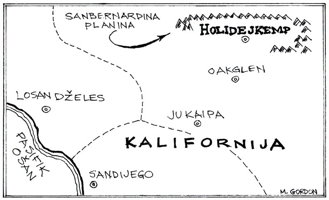
Holidejkemp Map |
Holidejkemp is one of the many villages whose colorful ethnic natives still preserve a rich folk tradition. Tonight we will discuss their St. Evrydiki's Day Festival, which is traditionally an excuse for a week-long drunk between Christmas and New Year's.
The villagers gather at a dancing site high in the mountains in their curious metal vehicles, many of which have been handed down for generations. They then engage in bizarre rituals aimed at bringing snow. These rituals, which are almost always unsuccessful, are so obscure that noted ethnic researchers such as I are unable to make heads or tails of them, as are the villagers themselves, many of whom are not very intelligent.
I would now like to present a typical colorful peasant of the Holidejkemp area, dressed in the intricate local costume. She is actually Laurie Gordon, co-artistic director of Kolo Ansambl Narodni Ersatz, a noted expert on Esperanto culture.
(ENTER LAURIE)
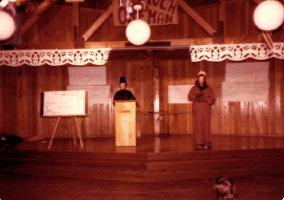
Mike & Laurie Gordon |
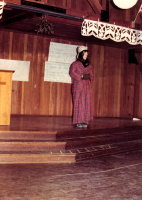
Laurie Gordon |
Before I explain the origin and function of her many quaint and colorful costume pieces, Laurie will perform a brief dance of the Holidejkemp area to music of a local village orchestra.
(MUSIC; LAURIE MIMICS EATING)
The first feature of the costume I will explain are the elaborately worked sandals, which are known as "adidas." The sole is made from the sap of a tree and the uppers are constructed of surplus surrender flags from the Partisan days. The stripes on the sides indicate one's marital status – in this case, ready, willing, and able. The construction of the sandal is extremely uncomfortable for dancing, and thus is widely used for that purpose, especially in the men's intricate ankle clicks.
Laurie also is wearing a typical headdress of the region. Early researchers believed they were worn to keep out the cold, but this superficial explanation has been thoroughly discredited by my research, which shows that its form is actually patterned after a local form of skin decoration, which the villagers call a "bandaid." It is tightly bound and is never removed except when the villagers take a shower, which is once a year, whether they need it or not.
Her overmantle, or "batrobe," as it is locally called, is highly decorated in the usual village fashion. It is made of the typical beaten polyester, which is made of traditional local chemicals and sewn together by a group of old women the villagers call a "k-mart."
(LAURIE PEELS OFF ROBE, REVEALING MIKE'S JACKET)
The undermantle is traditionally fastened with curious metal hooks, which are believed to be derived from the tops of village soft drink containers. The blue collor represents the pricise shade of the print on the region's drivers' licenses.
(LAURIE PEELS OFF JACKET, REVEALING BRA OVER SOMETHING)
The small decorative garment you see is called a "plahtex" and for unknown reasons, is only worn by women. The only women who have no use for it are the members of a ritual clan called the Notingupfront, whose president recently visited Holidejkemp to teach Transylvanian jokes.
(LAURIE SHEDS PANTS TO REVEAL THERMAL UNDERWEAR)
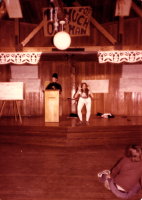
Mike & Laurie Gordon |
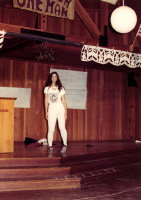
Laurie Gordon |
Beneath the outer garment, which Laurie just removed, is a garment called by a variety of names ("levis," "dittos," "wranglers") and known locally as the "longjohn," a leg covering believed to represent the bark of a sapling apple tree, in that it "covers the stems," as a local saying has it, or, as they are called in the colorful local Holidejkemp dialect,"gams."
Beneath these ritual garments are several others, which are of little interest except to the young men of Holidejkemp, who have a quaint custom of attempting to remove them whenever possible.
Actually, the Holidejkemp region has a very boring folk culture, consisting mostly of road apple rituals, parking lot dances, and colorful searches for hot water early in the morning. Their only significant cultural creations include the rubberized scrambled egg, the shinsplint, and the refigerated room.
In fact, to tell you the truth, I have completely wasted fifteen years of my life investigating the folklore of the Holidejkemp villagers, and I don't see any reason to continue. Laurie agrees, and we have decided to concentrate our further researches on the folk dances of Tahiti and Monte Carlo.
So, this closes tonight's program, and we thank you all very much for paying the admission fee. Good night, or as the Holidejkemp villagers say, "Close the stinking door!" Thank you!
(MIKE AND LAURIE BOW AND EXIT)
###
